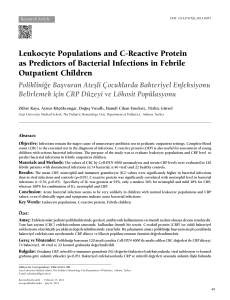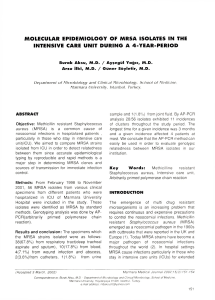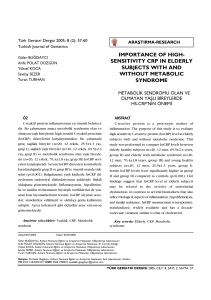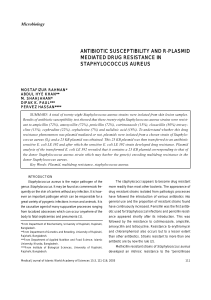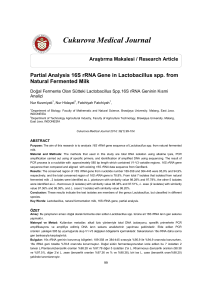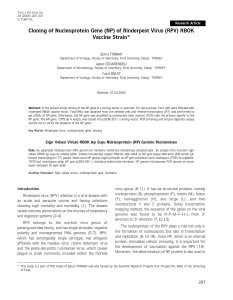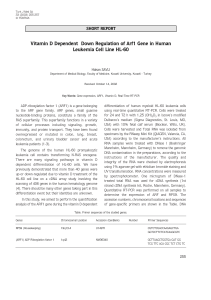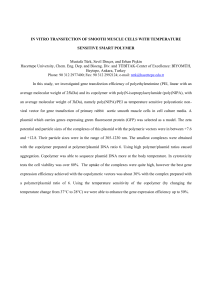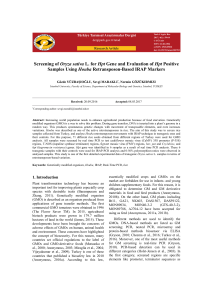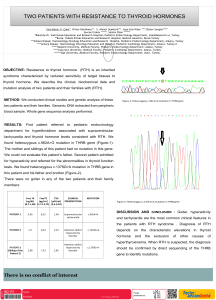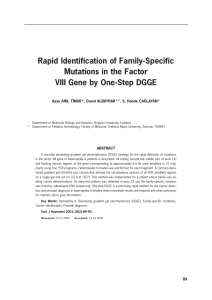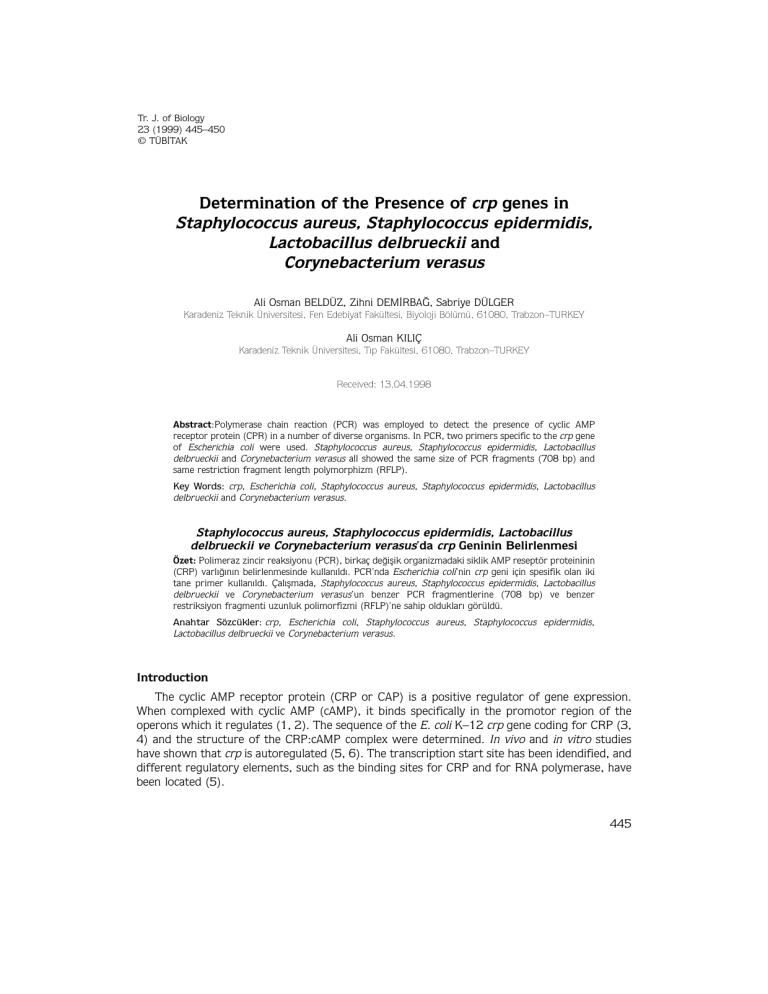
Tr. J. of Biology
23 (1999) 445–450
© TÜBİTAK
Determination of the Presence of crp genes in
Staphylococcus aureus, Staphylococcus epidermidis,
Lactobacillus delbrueckii and
Corynebacterium verasus
Ali Osman BELDÜZ, Zihni DEMİRBAĞ, Sabriye DÜLGER
Karadeniz Teknik Üniversitesi, Fen Edebiyat Fakültesi, Biyoloji Bölümü, 61080, Trabzon–TURKEY
Ali Osman KILIÇ
Karadeniz Teknik Üniversitesi, Tıp Fakültesi, 61080, Trabzon–TURKEY
Received: 13.04.1998
Abstract:Polymerase chain reaction (PCR) was employed to detect the presence of cyclic AMP
receptor protein (CPR) in a number of diverse organisms. In PCR, two primers specific to the crp gene
of Escherichia coli were used. Staphylococcus aureus, Staphylococcus epidermidis, Lactobacillus
delbrueckii and Corynebacterium verasus all showed the same size of PCR fragments (708 bp) and
same restriction fragment length polymorphizm (RFLP).
Key Words: crp, Escherichia coli, Staphylococcus aureus, Staphylococcus epidermidis, Lactobacillus
delbrueckii and Corynebacterium verasus.
Staphylococcus aureus, Staphylococcus epidermidis, Lactobacillus
delbrueckii ve Corynebacterium verasus’da crp Geninin Belirlenmesi
Özet: Polimeraz zincir reaksiyonu (PCR), birkaç değişik organizmadaki siklik AMP reseptör proteininin
(CRP) varlığının belirlenmesinde kullanıldı. PCR’nda Escherichia coli’nin crp geni için spesifik olan iki
tane primer kullanıldı. Çalışmada, Staphylococcus aureus, Staphylococcus epidermidis, Lactobacillus
delbrueckii ve Corynebacterium verasus’un benzer PCR fragmentlerine (708 bp) ve benzer
restriksiyon fragmenti uzunluk polimorfizmi (RFLP)’ne sahip oldukları görüldü.
Anahtar Sözcükler: crp, Escherichia coli, Staphylococcus aureus, Staphylococcus epidermidis,
Lactobacillus delbrueckii ve Corynebacterium verasus.
Introduction
The cyclic AMP receptor protein (CRP or CAP) is a positive regulator of gene expression.
When complexed with cyclic AMP (cAMP), it binds specifically in the promotor region of the
operons which it regulates (1, 2). The sequence of the E. coli K–12 crp gene coding for CRP (3,
4) and the structure of the CRP:cAMP complex were determined. In vivo and in vitro studies
have shown that crp is autoregulated (5, 6). The transcription start site has been idendified, and
different regulatory elements, such as the binding sites for CRP and for RNA polymerase, have
been located (5).
445
Determination of the Presence of crp genes in Staphylococcus aureus, Staphylococcus epidermidis, Lactobacillus
delbrueckii and Corynebacterium verasus
CRP is a dimer with a molecular weight of 45 000 and 209 amino acid residues in each
subunit. Each subunit of the CRP dimer folds into two domains. The two subunits have different
conformations. In the subunit in the “closed” conformation, the carboxy–terminal and
amino–terminal domains lie closer together than in the “open” conformation, with a larger
amino–terminal domain that extends from amino acid 1 to 129 and a smaller carboxy–terminal
domain that continues from amino acid 139 to 209. The two domains are connected by a
“hinge” region of residues 130 to 138, which has a very different conformation in the two
subunits (7).
The secondary structure of CRP consists of six α–helices (αA, αB, αC, αD, αE, and αF),
eight strands forming β–roll (β1, β2, β3, β4, β5, β6, β7 and β8) and four β–sheet in a small
domain of CRP (β9, β10, β11, and β12) (7).
Earlier, the presence of crp genes was shown in E. coli K–12, Shigella flexneri 2B, Salmonella
typhimirium (8) and Klebsiella aerogenes (9). Anderson and Pastan (10) have shown the
presence of a similar protein in Photobacterium fisheri, Aerobacter aerogenes and Proteus
mirabilis. Some other papers have indicated the presence of crp genes in a number of diverse
organisms: Vibrio fischeri (11), Salmonella choleraesuis (12), Bradyrhizobium japonium (13),
Haemophilius influenzae and (14) Salmonella typhi (15). This is the first study to determine the
presence of crp genes in the indicated bacteria.
Our interest in elucidating the role of the structure in CRP function prompted us to search
for the presence of the CRP gene and to analyze the structure of this gene in different bacteria.
By using polymerase chain reaction (PCR) amplification, we amplified and cloned the crp genes
of Lactobacillus delbruckii, Staphylococcus epidermidis, Staphylococcus aureus and
Corynebacterium verasus.
Materials and Methods
Materials
Luria–Bertani (LB) media have been described by Maniatis et al. (16). Restriction
endonucleases were purchased from New England Biolabs and Promega. All enzymes were used
according to the instructions of the suppliers.
Bacterial strains: For the amplification, the starting strain were Staphylococcus aureus RSKK
250, Staphylococcus epidermidis ATCC 146, Lactobacillus delbrueckii supsp. lactic ATCC 15808,
Corynebacterium verasus. ATCC 6931, Bacillus subtilis ATCC 6633, Bacillus cereus ATCC 6464,
Neisseria flavescens ATCC 13120 and Proteus vulgaris 6659
Methods
PCR amplification: Extraction and purification of genomic DNA were performed with
approximately 0.25 mg (wet weight) of cells from fresh LB cultures according to Maniatis et al.
(16). DNA pellets were resuspended in TE buffer (10 mM Tris–HCl, 1 mM EDTA; pH 8.0). The
integrity of the DNA was checked by horizontal gel electrophoresis in 1% agarose. The crp gene
was selectively amplified from purified genomic DNA with oligonucleotide primers designed to
anneal to positions in the 3’ and 5’ regions of bacterial crp genes. The 5’ primer is
446
A. O. BELDÜZ, Z. DEMİRBAĞ, S. DÜLGER, A. O. KILIÇ
5’–CCATATGGTGCTTGGC–3’ and 3’ primer is 5’–CGAGCTCAGTCTGCGCCAC–3’. Primers were
supplied by GBF–Braunschweig, Germany.
The reaction conditions were as follows: 12 ng of template DNA, 5 µl of 10 x PCR buffer
(100 mM Tris–HCl: pH 8.3, 500 mM KCl), 1.5 mM MgCl2, 2 U of Taq DNA polymerase, 0.25
mM of each primer, and 170 µM dATP, 170 µM dCTP, 170 µM dGTP, 170 µM dTTP were
combined in a total volume of 50 µl. Amplification was carried out in 500 µl tubes in a Techne
Progene Fuse 230U TZA Thermal Cycler as follows: a preliminary denaturation step was done
at 95°C for 2 min. followed by 36 cycles of 1 min at 94°C, 1 min at 56°C and 2 min at 72°C.
PCR products were electrophoresed at 10 V cm–1 in 1% agarose in TBE (0.089 M
Tris–borate, 0.089 M boric acid and 0.002 M EDTA) buffer containing ethidium bromide (0.5
mg/ml).
Restriction enzyme digestion was performed with 6 µg of the PCR product at 37°C for 2
hrs, and electrophoresed in 1.5% agarose gel.
Results
We amplified the crp genes from Staphylococcus aureus, Staphylococcus epidermidis,
Lactobacillus delbrueckii and Corynebacterium verasus by PCR (Figure 1) and cloned 708 bp crp
fragments into Sma I site of M13mp18. M13mp18crpWT was used as a positive control (17).
There were no PCR products in the samples from the other species listed in Materials.
Consistently, no fragments was determined by PCR in other species indicated in Materials (data
not shown).
Restriction digestions of PCR products produced the expected fragment sizes (on the basis
of E. coli crp gene results) 124, 444 and 440 bp long fragments with Alw NI; 39, 291 and 378
with Taq I; and 150, 224 and 334 with Msp I. The restriction maps of the crp regions of E. coli
and others were very similar. Alw NI, Taq I and Msp I sites were at the same (or very close)
locations in all organisms (Figure 2).
1
2
3
4
5
6
7
Figure 1.
M
crp fragments from PCR.
Lanes: (1), Negative control
by using M13mp18; (2),
Positive control, M13crp
(Belduz et al, 1994); (3), E.
coli B; (4), Staphylococcus
aureus; (5), Staphylococcus
epidermidis; (6), Lactobacillus
delbrueckii supsp. lactic; (7),
Corynebacterium verasus.
805 bp
514 bp
447
Determination of the Presence of crp genes in Staphylococcus aureus, Staphylococcus epidermidis, Lactobacillus
delbrueckii and Corynebacterium verasus
Taq I
1
2
3
Msp I
4
5
1
2
3
Alw NI
4
5
1
2
3
4
5
M
404 bp
242 bp
147 bp
111 bp
Figure 2.
Restriction digestion of PCR products. Restriction endonucleases used are indicated on the top the figure.
Lanes: (1) M13crp (19); (2), E. coli B; (3), Staphylococcus aureus; (4), Staphlococcus epidermidis; (5),
Lactobacillus delbrueckii supsp. lactic; (6), Corynebacterium verasus.
Discussion
The role of cyclic AMP (cAMP) in mediating the glucose effect on the induction of catabolic
enzymes in E. coli and its relatives is familiar. cAMP mediates its effect by binding to cyclic AMP
receptor protein (CRP) in E. coli and its relatives. There are now many reports of cAMP in many
nonenteric bacteria, but little is known about the role of the nucleotide in these bacteria. In many
cases, cAMP appears not to mediate the glucose effect observed for induction of catabolic
enzymes. Mutants lacking adenylate cyclase have not yet been isolated in these less familiar
bacteria. In some cases, no cAMP dependent functions have been found, but no function for
these proteins has been established (18).
At present, although only the presence of CRP in some enteric and nonenteric bacteria has
been shown, the primary structures of CRP from three enteric bacteria other than E. coli have
been determined, and the identity of E. coli CRP has been shown. In this study, the presence of
crp genes was shown by PCR in bacteria other than enterics and identity of these genes to E.
coli crp gene was indicated by digesting with restriction endonucleases.
Alw NI recognises positions 145, 147, which are involved in the αD, 193 and 195 which are
between αF and β11, of CRP. One of Taq I recognition region corresponds to positions 11 and
12 in αA and the other corresponds to positions 137 and 138 of CRP, which are in the bridge
region that connects the large and small domains of CRP. Msp I recognition regions involves the
positions 110, 111, 160 and 161 of CRP. Corresponding structure in CRP for the position 110
is β9, β10, αB and αC which is responsible for intersubunit interaction. CRP from all strains
did not show any difference in these positions.
448
A. O. BELDÜZ, Z. DEMİRBAĞ, S. DÜLGER, A. O. KILIÇ
Reason for detecting no fragment for crp gene in other species given in Materials can be
either sequence differences of the gene in these species or absence of crp gene. Contrary to the
result of immunological studies of Anderson and Pastan (10), we have been able to show the
presence of crp gene is Staphylococcus aureus by PCR.
References
1.
Ebright, R.H., Cossart, B., Gicquel–Sanzey, B., and Beckwith, J. Mutations that alter the DNA sequence of the
catabolite gene activator proteins of E. coli. Nature, 311: 223–235, 1984.
2.
Ullmann, A., and Danchin, A. Role of cyclic AMP in bacteria. Adv. Cyclic Nucleotide Res, 15: 1–53, 1983.
3.
Aiba, H., Fujimoto, S., and Ozaki, N. Molecular cloning and nucleotide sequencing of the gene for E. coli cAMP
receptor protein. Nucleic Acids Res. 10: 1345–1362, 1982.
4.
Cossart, P. and Gicquel–Sanzey, B. Cloning and sequence of the crp gene of E. coli K12. Nucleic Acids Res. 10:
1363–1378, 1982.
5.
Aiba, H. Autoregulation of the Escherichia coli crp gene: CRP is a transcriptional repressor for its own gene. Cell.
32: 141–149, 1983.
6.
Cossart, P., and Gicquel–Sanzey, B. Regulation of expression of the crp gene of Escherichia coli K–12: in vivo
study. J. Bacteriol. 161: 454–457, 1985.
7.
Weber, I.T., and Steitz, T.A. Structure of a complex of catabolite gene activator protein and cyclic AMP refined at
2.5 A resolution. J. Mol. Biol. 198: 311–326, 1987.
8.
Cossart, P., Groisman, E.A., Serre, M.C., Casadaban, M.J., and Gicquel–Sanzey, B. crp genes of Shigella flexneri,
Salmonella typhymurium, and Escherichia coli. J. Bacteriol. 167: 639–646, 1986.
9.
Osuna, R., Boylan, A., and Bender, R.A. In vitro transcription of the histidine utilization (hut UH) operon from
Klebsiella aerogenes. J. Bacteriol. 173: 116–123, 1991.
10.
Anderson, W.B., and Pastan, I. The cyclic AMP receptor of Escherichia coli: Immunological studies in extracts of
Escherichia coli and other organisms, 1973.
11.
Shadel, G.S., and Baldwin, T.O. The Vibrio fischeri LuxR protein is capable of bidirectional stimulation of
transcription and both positive and negative regulation of the LuxR gene. J. Bacteriol. 173: 568–74, 1991.
12.
Kelly, S.M., Bosecker, B.A., Curtiss, R. 3d. Characterization and protective properties of attenuated mutants of
Salmonella choleraesuis. Infect–Immun. 60: 4881–90, 1992.
13.
Anthamatten, D., Scherb, B., Hennecke, H. Characterization of a fix Lj–regulated Bradyrhizobium japonicum gene
sharing similarity with the Escherichia coli fnr and Rhizobium melinoti fixK genes. J. Bacteriol. 174: 2111–20,
1992.
14.
Chandler, M.s. The gene encoding cAMP receptor protein is required for competence development in Haemophilus
influenzae Rd. Proc. Natl–Acad–Sci. 82: 1626–30, 1992.
15.
Tacket, C.O., Hone, D.M., Curtiss, R., Kelly, S.M., Losonsky, G., Guers, L., Harris, A.M., Edelman, R., Levine, M.N.
Comparison of the safety and immunogenicity of delta aroC, delta aroD and delta cya delta cry Salmonella typhi
strains in adult volunteers. Infect–Immun. 60: 536–41, 1992.
449
Determination of the Presence of crp genes in Staphylococcus aureus, Staphylococcus epidermidis, Lactobacillus
delbrueckii and Corynebacterium verasus
16.
Maniatis, T., Fritsch, E.F. and Sambrook, J. Molecular Cloning: A Laboratory Manual., Cold Spring Harbor, New
York, 1982, Cold Spring Harbor Laboratories.
17.
Belduz, Ali. O., Lee, Eun Ju and Harman, James G. Mutagenesis of the cyclic AMP Receptor Protein of E. coli:
Targeting positions 72 and 82 of the cyclic nucleotide binding pocket. Nucleic Acids Research, 21, 1827–1835,
1993.
18.
Botsford, J.L., and Harman, J.G. Cyclic AMP in procaryotes. Microbiological Reviews. 56: 100–122, 1992.
19.
Lee, E.J., Glasgow J., Belduz, A.O., and Harman, J.G. Mutagenesis of the cyclic AMP Receptor Protein of E. coli:
Targeting positions 83, 127 and 128 of the cyclic nucleotide binding pocket. Nucleic Acids Research, 22:
2894–2901, 1994.
450

